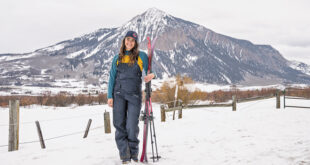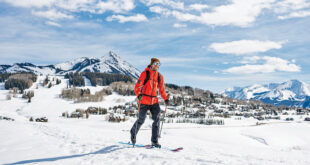Sigrid Cottrell and her two tow-headed brothers would spend every summer 200 kilometers above the Arctic Circle in her mother’s homeland of Kiruna, Sweden, visiting their grandparents. “I lived where the reindeer roamed,” Sigrid recalls of the area’s spaciousness but notes, “Swedes live very small,” and in mostly apartments in Kiruna. Sigrid says, “They’re practical people. They don’t have a ‘bigger is better’ mentality. They care about the environment and are very forward thinking in all of that.”
Fluent in English and Swedish, Sigrid grew up Swedish in an American society. “We were very independent as children and we had each other. Despite fighting like cats and dogs, we were always there for each other. I was a scrapper having to grow up with two brothers.”
Her parents were real estate developers who moved around quite a bit, leaving Sigrid’s hometown of Princeton, N.J., when she was eight years old. They bought houses for speculation and then sold them and moved on to buy homes in places like Palm Beach and Del Ray in Florida. “Moving around so much as kids helped us learn to adapt to any environment. That’s why traveling is so wonderful, because you learn to do that,” Sigrid says.
Her parents bought a large hotel on 1,000 acres in northern New Jersey, only an hour and a half from New York City. “We lived in half of the third floor in the main building,” Sigrid says of the massive hotel on a lake. It was a child’s dream home with lots of outdoor adventures like canoes, sailboats, and water skiing. The hotel boasted 23 bars, live concerts and a cave-like nightclub with stalactites hanging from the ceiling. Their parents had named it the Scandia Spa and envisioned a health-conscious resort complete with equestrian activities and a golf course.
“While we were in Sweden one summer, the main building burned down. That was an end of an era. We lost everything, including our dog, everything from our childhood, so we stayed in Sweden for a year and went to school while my dad tried to rebuild our lives,” Sigrid says, painfully remembering when she was 13 years old.
When Sigrid graduated from high school in 1986 she had no idea what she wanted to do. She didn’t really want to go to college but decided to attend classes as a non-matriculated student. “I went to the classes but not for grades. I went strictly to learn,” she explains. “There was so much pressure to get good grades instead of learning the content of the class.”
She took classes for a couple of years while bouncing between Florida and New York. She had already gotten her real estate license in Florida at the age of 18 and was actively employed but through her wanderings, she ended up bartending.
Working those relentless bar shifts took an obvious toll on Sigrid and one day, one of her regulars handed her a gift plane ticket to Gunnison, a $100 bill and the phone number of his friend living here—Murdoch.
“And that’s how I got to Crested Butte,” she laughs, recalling that 1991 trip. “I get off the plane and there was Murdoch waiting for me with his unibrow mad scientist look and a bag of oranges, which he said would help me quit smoking. I was a little leery and thought, ‘What am I doing here in the middle of nowhere?’ His house looked like Herman Munster’s but I stayed there and of course it was fine, although it was cold as hell in his house even though it was summer. He was quirky but never inappropriate to me.”
Sigrid wound up staying in Colorado for three weeks, leaving Crested Butte for Boulder after the first week. One of her brothers also happened to be in Boulder, as a volunteer to feed the homeless. “I go up to the first homeless person I meet on the courthouse lawn and asked if he knew my brother who was serving food. The guy tells me, ‘You’ll find him at Penny Lane playing chess every day.’” Sure enough, the next day she found her bro at that coffeehouse.
What she didn’t realize at the time was that her brother was also basically homeless, living out of his car and camping. “We were like the homeless feeding the homeless but it was the most freeing experience I ever had. It was having no responsibilities and wherever the day took me, that’s where I went.”
After three incredible weeks of volunteering with her brother, Sigrid decided to go home, get back to work and save enough money to move to Colorado. It took only a mere three weeks and she loaded up a bubble trailer and headed west with all her belongings, arriving in Crested Butte in the late summer of ‘91. She landed a job at the brand new Avalanche on Mt. Crested Butte and moved on to Kochevar’s as a cocktail waitress and bartender. She even worked at the bead shop, making necklaces and selling beads.
The last day of skiing of 1994, while sitting in the middle of the floor in Forest Queen with a Sambuca in hand, she met Chris Cottrell, whom she married in 1997. Their daughter, Ayla, was born in 1995, and Kiara in 1999.
After the couple divorced in 2008, Sigrid moved to San Diego to catch a little warm weather for a spell. “I wanted a one-year break from the snow and cold. It was a big adventure because I moved there without knowing anyone. I had worked so hard for so long my whole life and my life basically blew up. I had to make a choice for my children, based on what was best for them,” Sigrid says of the move.
She stayed for three years, working in real estate. When her lease was up for the house they were living in and she couldn’t find another rental, her daughter Ayla suggested the obvious, “Ayla just looked at me and said, ‘Why don’t we just go home?’” Sigrid made just one phone call and they moved back home immediately, Sigrid working for Red Lady Realty.
After the Fukushima meltdown released deadly amounts of radiation, Sigrid felt the incident needed immediate remediation. She teamed up with her long-time friend, Andy Heath, who was the only person she knew in her sphere of people who might possibly have some sort of ideas for a solution. “I knew that the radiation and the leakage was going to affect the food supply globally and no one was even talking about it. He’s been a scientist of hydrogen energy for three decades. He sent me a PowerPoint the next day. It started a concept about changing world energy from dirty to clean fuels,” Sigrid says.
The two came up with a plan to launch a marketing campaign for their project, meeting with everyone from the Departments of Defense and Energy to Lockheed Martin and Boeing.
“We don’t need anything but sunlight and water to power the world,” Sigrid says confidently. “It takes about 13 gallons of water to make one gallon of gasoline, but it takes only 2.8 gallons of water to make the equivalent of one gallon of hydrogen – but here’s the sweet spot… you get the water back with hydrogen production, whereas you don’t with gasoline production. Right now, 100 hydrogen refueling stations are being built in California for vehicles, and there are 400 refueling stations going into Germany. Japan just allocated $400M for hydrogen energy infrastructure,” she explains and adds that twenty years ago the town of Crested Butte rejected a plan presented by her partner utilizing the waste water treatment plant to make hydrogen to power the town vehicles including the Mountain Express busses.
Their companies are Solar Hydrogen and HyCarb (Hycarbinc.com and solarhydrogeninc.com). HyCarb has four advanced carbon material patents. They’re focusing on developing a less toxic, significantly higher performance and longer life battery that’s also almost 100% recyclable, and can be formed to any shape, from small batteries to phone batteries to electric vehicles, etc…“And they won’t catch fire, which is a big deal when you’re talking to the Department of Defense (DOD),” she tells.
They’re starting an indiegogo.com crowd funding campaign to complete the first project, hoping that having their team of notable engineers, Ph.D.s, scientists, and electro-chemists from one of the nation’s largest universities will attract donors to help them develop the prototype. “The planet is completely recoverable, fixable, but we have to start massive action right bleeping now,” she says decidedly.
Moving so much as a child is one of the reasons Sigrid chooses to stay put in Crested Butte. “Part of why I’ve been here so long with my own kids was to give them that sense of stability. It felt good to have that. We’re here in Crested Butte because we’re safe and we love it. This is home and we want to be where we’re protected by our environment, our friends and family. I mean, have you been out there lately? It’s crazy! You can’t live outside of the Shire,” Sigrid grins.
“We may have to travel a lot to accomplish what we want and need to do for the planet and its people, but it’s worth it. And we get to come home to Crested Butte.”
Check Also
Profile: Sarah Quinlivan
By Dawne Belloise They met on Match.com right after COVID was deemed to have …
 The Crested Butte News Serving the Gunnison Valley since 1999
The Crested Butte News Serving the Gunnison Valley since 1999




